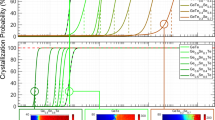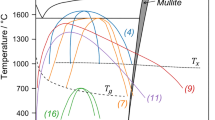Abstract
Although the majority of glasses in use in technology are complex mixtures of oxides or chalcogenides, there are numerous examples of pure substances—‘glassformers’—that also fail to crystallize during cooling. Most glassformers are organic molecular systems, but there are important inorganic examples too1,2, such as silicon dioxide and elemental selenium (the latter being polymeric). Bulk metallic glasses can now be made3; but, with the exception of Zr50Cu50 (ref. 4), they require multiple components to avoid crystallization during normal liquid cooling. Two-component ‘metglasses’ can often be achieved by hyperquenching, but this has not hitherto been achieved with a single-component system. Glasses form when crystal nucleation rates are slow, although the factors that create the slow nucleation conditions are not well understood. Here we apply the insights gained in a recent molecular dynamics simulation study5 to create conditions for successful vitrification of metallic liquid germanium. Our results also provide micrographic evidence for a rare polyamorphic transition preceding crystallization of the diamond cubic phase.
This is a preview of subscription content, access via your institution
Access options
Subscribe to this journal
Receive 51 print issues and online access
$199.00 per year
only $3.90 per issue
Buy this article
- Purchase on Springer Link
- Instant access to full article PDF
Prices may be subject to local taxes which are calculated during checkout



Similar content being viewed by others
References
Privalko, Y. Excess entropies and related quantities in glass-forming liquids. J. Phys. Chem. 84, 3307–3312 (1980)
Martinez, L. M. & Angell, C. A. A thermodynamic connection to the fragility of glass-forming liquids. Nature 410, 663–667 (2001)
Johnson, W. L. Bulk glass-forming metallic alloys: science and technology. Mater. Res. Soc. Bull. 24, 42–50 (1999)
Wang, W. H., Lewandowski, J. J. & Greer, A. L. Understanding the glass-forming ability of Cu50Zr50 alloys in terms of a metastable eutectic. J. Mater. Res. 20, 2307–2313 (2005)
Molinero, V., Sastry, S. & Angell, C. A. Tuning of tetrahedrality in a silicon potential yields a series of monatomic (metal-like) glasse formers of very high fragility. Phys. Rev. Lett. 97, 075701 (2006)
Cohen, M. H. & Turnbull, D. Composition requirements for glass formation in metallic and ionic systems. Nature 189, 131–132 (1961)
van Ketel, W., Das, C. & Frenkel, D. Structural arrest in an ideal gas. Phys. Rev. Lett. 94, 135703 (2005)
Hilsch, R. in Non-Crystalline Solids (ed. Frechette, V. D.) 348 (J. Wiley and Sons, New York, 1960)
Chathoth, S. M., Meyer, A., Koza, M. M. & Juranyi, F. Atomic diffusion in liquid Ni, NiP, PdNiP, and PdNiCuP alloys. Appl. Phys. Lett. 85, 4881–4883 (2004)
Wachtel, E. et al. Magnetic-susceptibility and DSC study of the crystallization of melt-quenched Ni-P amorphous-alloys. Mater. Sci. Eng. A 133, 196–199 (1991)
Stillinger, F. H. & Weber, T. A. Computer-simulation of local order in condensed phases of silicon. Phys. Rev. B 31, 5262–5271 (1985)
Angell, C. A., Borick, S. & Grabow, M. Glass transitions and first order liquid-metal-to-semiconductor transitions in 4–5–6 covalent systems. J. Non-Cryst. Solids 207, 463–471 (1996)
Brazhkin, V. V., Larchev, V. I., Popova, S. V. & Skrotskaya, G. G. The influence of high pressure on the disordering of the crystal structure of solids rapidly quenched from the melt. Phys. Scr. 39, 338–340 (1989)
Tanaka, H. Simple view of waterlike anomalies of atomic liquids with directional bonding. Phys. Rev. B 66, 064202 (2002)
Koga, J., Nishio, K., Yamaguchi, T. & Yonezawa, F. Tight-binding molecular dynamics study on the structural change of amorphous germanium with the increase of density. J. Phys. Soc. Jpn 73, 388–396 (2004)
Schnydersy, H. S. & Van Zytveldz, J. B. Electrical resistivity and thermopower of liquid Ge and Si. J. Phys. Condens. Matter 8, 10875–10883 (1996)
Zhang, F. X. & Wang, W. K. Microstructure of germanium quenched from the undercooled melt at high-pressures. Appl. Phys. Lett. 67, 617–619 (1995)
Brazhkin, V. V., Lyapin, A. G., Popova, S. V. & Voloshin, R. N. Non-equilibrium phase transitions and amorphization in Si, Si/GaAs, Ge, and Ge/GaSb at the decompression of high-pressure phases. Phys. Rev. B 51, 7549–7554 (1995)
Salmon, P. S. A. Neutron-diffraction study on the structure of liquid germanium. J. Phys. F 18, 2345–2352 (1988)
Ankele, J., Mayer, J., Lamparter, P. & Steeb, S. Structure factor of amorphous-germanium by quantitative electron-diffraction. J. Non-Cryst. Solids 193, 679–682 (1995)
Etherington, G. et al. A neutron-diffraction study of the structure of evaporated amorphous-germanium. J. Non-Cryst. Solids 48, 265–289 (1982)
Benmore, C. J. et al. Intermediate range chemical ordering in amorphous and liquid water, Si, and Ge. Phys. Rev. B 72, 132201(4) (2005)
Aptekar, L. I. Phase transitions in non-crystalline germanium and silicon. Sov. Phys. Dokl. 24, 993–995 (1979)
Voronin, G. A. et al. In situ X-ray diffraction study of germanium at pressures up to 11 GPa and temperatures up to 950 K. J. Phys. Chem. Solids 64, 2113–2119 (2003)
Li, D. & Herbach, D. M. Containerless solidification of germanium by electromagnetic levitiatioins and in a drop-tube. J. Mater. Sci. 32, 1437–1442 (1997)
Sastry, S. & Angell, C. A. Liquid–liquid phase transition in supercooled liquid silicon. Nature Mater. 2, 739–743 (2003)
Ponyatovsky, G. G. A thermodynamic approach to T-P phase diagrams of substances in liquid and amorphous states. J. Phys. Condens. Matter 15, 6123–6141 (2003)
Mishima, O. Reversible transition between two H2O amorphs at ∼0.2 GPa and ∼135 K. J. Chem. Phys. 100, 5910–5919 (1991)
Aasland, S. & McMillan, P. F. Density-driven liquid–liquid phase-separation in the system Al2O3–Y2O3 . Nature 369, 633–636 (1994)
Kurita, R. & Tanaka, H. Critical-like phenomena associated with liquid-liquid transition in a molecular liquid. Science 306, 845–848 (2004)
Spaepen, F. & Turnbull, D. in Laser-Solid Interactions and Laser Processing 1978 (eds Ferris, S. D., Leamy, H. J. & Poate, J.). AIP Conf. Proc. 50, 73–83 (1979)
Stanley, H. E. et al. The puzzling behavior of water at very low temperature. Phys. Chem. Chem. Phys. 2, 1551–1558 (2000)
Rez, D., Rez, P. & Grant, I. Dirac-Fock calculations of X-ray scattering factors and contributions to the mean inner potential for electron scattering. Acta Crystallogr. A 50, 481–497 (1994)
Plimpton, S. Fast parallel algorithms for short-range molecular-dynamics. J. Comput. Phys. 117, 1–19 (1995)
Grabow, M. H. & Gilmer, G. H. Thin-film growth modes, wetting and cluster nucleation. Surf. Sci. 194, 333–346 (1988)
Yu, W. B. & Stroud, D. Molecular-dynamics study of surface segregation in liquid semiconductor alloys. Phys. Rev. B 56, 12243–12249 (1997)
Acknowledgements
We thank C. Benmore and Q. Mei for the attempted in situ studies of melt-quenched samples at the Argonne APS. We acknowledge the allocation of computer time at the Center for High Performance Computing at the University of Utah, where the simulations on Ge were carried out. The cooperation of D. Matyushov and his group (whose Arizona State University computing facilities were used for the Si simulations) is also appreciated. We also thank our NSF-CRC colleagues P. Debenedetti, G. Stanley and P. Rossky for discussions. This work was supported by NSF grants from the Chemistry CRC (to C.A.A.), the DMR Solid State Chemistry (to C.A.A.), the NSF Chemistry (to J.L.Y.), the Carnegie/DOE Alliance Center (DOE-NNSA CDAC) (to J.L.Y.) and the Swarnajayanti Fellowship, DST, India (to S.S.). The TEM studies depended on the John M. Cowley Center for High Resolution Electron Microscopy.
Author Contributions C.A.A., V.M. and S.S. conceived the project as part of previous work5. J.L.Y. recommended and directed the DAC investigation, M.H.B. and E.S. executed the sample mounting, laser pulse melting, and Raman characterization experiments, V.C.S. and M.H.B. performed the TEM studies, V.M. carried out both preliminary Si and later Ge molecular dynamics simulations, and wrote the results analysis given in the Supplementary Information, and C.A.A. wrote the paper (with advice and criticism from all co-authors).
Author information
Authors and Affiliations
Corresponding author
Ethics declarations
Competing interests
Reprints and permissions information is available at www.nature.com/reprints. The authors declare no competing financial interests.
Supplementary information
Supplementary Information
This file contains Supplementary Notes illustrated with Supplementary Figures and additional refrences. (PDF 795 kb)
Rights and permissions
About this article
Cite this article
Bhat, M., Molinero, V., Soignard, E. et al. Vitrification of a monatomic metallic liquid. Nature 448, 787–790 (2007). https://doi.org/10.1038/nature06044
Received:
Accepted:
Published:
Issue Date:
DOI: https://doi.org/10.1038/nature06044
This article is cited by
-
Investigation of structural phase transformation of Al metallic glass under uniaxial compression strain by molecular dynamics simulation
Applied Physics A (2023)
-
Single-element amorphous palladium nanoparticles formed via phase separation
Nano Research (2022)
-
Sonication induced amorphisation in Ag nanowires
Scientific Reports (2019)
-
An unusual type of polymorphism in a liquid crystal
Nature Communications (2018)
-
Frustration of crystallisation by a liquid–crystal phase
Scientific Reports (2017)
Comments
By submitting a comment you agree to abide by our Terms and Community Guidelines. If you find something abusive or that does not comply with our terms or guidelines please flag it as inappropriate.



